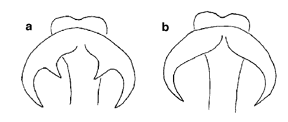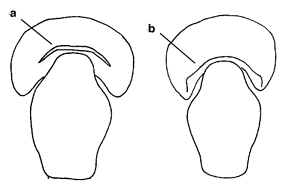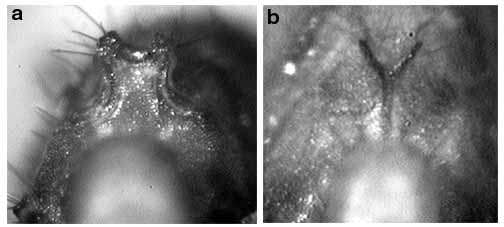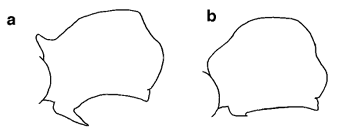
10a. Tarsal claws with an extra basal tooth: 100
10b. Tarsal claws simple (Neivamyrmex): 900

100a. Propodeum with dorsal teeth or flanges: 200
100b. Propodeum smoothly rounded (Labidus): 800

200a. Scapes very short and broad; no distinct soldier caste with long, hook-shaped mandibles (Nomamyrmex): 300
200b. Scapes relatively longer and thinner; often with soldiers with long, hook-shaped mandibles (Eciton): 400

300a. Back of head with deep transverse groove; top of petiole longitudinally wrinkled: Nomamyrmex esenbeckii wilsoni (moderately abundant species; diurnal and nocturnal surface foraging; raids in columns; attacks Atta nests)
300b. Back of head with a transverse line but without a deep groove; top of petiole smooth: Nomamyrmex hartigii (very rare; workers not collected at La Selva yet, but known from males)

400a. Petiole in side view relatively elongate and somewhat rectangular (note that presence or absence of a ventral spine on the petiole is variable within colonies of Eciton and is not a useful diagnostic character): 500
400b. Petiole in side view relatively shorter with dorsal profile more sloping: 700

500a. Minor workers with dark brown mesosoma and head, red-brown gaster; major workers with red-brown head: Eciton mexicanum (moderately abundant mostly nocturnal surface forager; raids in columns)
500b. Minor workers uniformly orange-red; major workers with light yellow-orange head: 600
600a. When propodeum viewed from the rear, propodeal spines or flanges descend separately on the lower face of propodeum: Eciton hamatum (common diurnal and nocturnal surface forager; raids in columns)
600b. Propodeal flanges fuse on lower face of propodeum, forming a raised "Y": Eciton lucanoides conquistador(common nocturnal surface forager; raids in columns; easily confused with hamatum)

700a. Petiole in lateral view with raised anterodorsal flange; minor workers dark brown with lighter red-brown gaster; major workers with red-brown head: Eciton vagans s.l. (moderately common nocturnal surface forager; raids in columns)
700b. Petiole without anterodorsal flange; minor worker color variable; major worker with yellow to white head: Eciton burchelli foreli (common diurnal and nocturnal surface forager; raids in carpets)

800a. Petiole with ventral tooth: 850
800b. Petiole without ventral tooth: Labidus praedator (rare diurnal and nocturnal surface forager; raids in carpets)

850a. Face largely smooth and shiny; worker color bright red-brown: Labidus coecus (common nocturnal forager; usually subterranean but occasionally on surface, especially when crossing cement or hard-packed trails; raids in columns)
850b. Face rough, not shiny; worker color dark brown: Labidus spininodis (very rare; workers not known from La Selva yet; one male tentatively identified as spininodis)
900a. Worker color black or dark red-brown; diurnal foragers: Neivamyrmex pilosus mexicanus (common diurnal and nocturnal surface forager; raids in columns)
900b. Worker color various but often red-brown: Neivamyrmex spp. (multiple species but rarely encountered; mostly nocturnal raids in columns; occasionally on surface)
Page author:
John T. Longino, The Evergreen State College, Olympia WA 98505 USA.longinoj@evergreen.edu